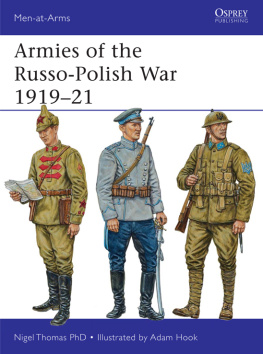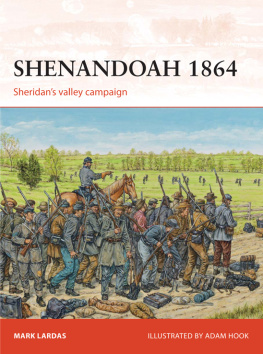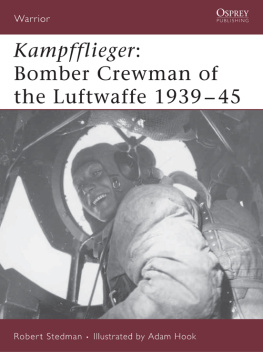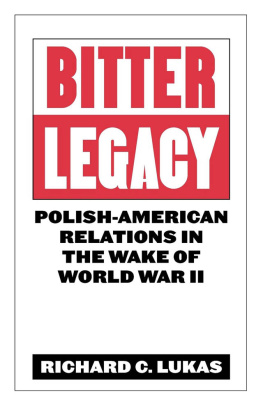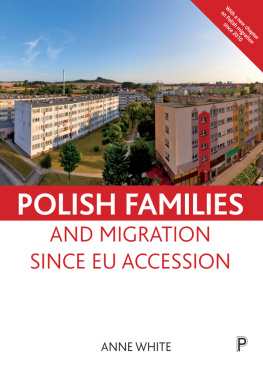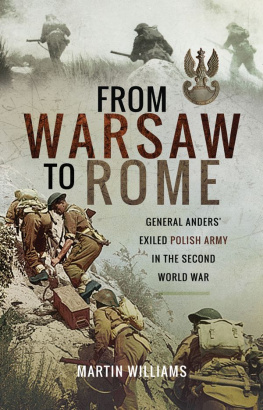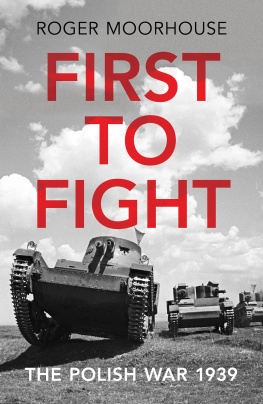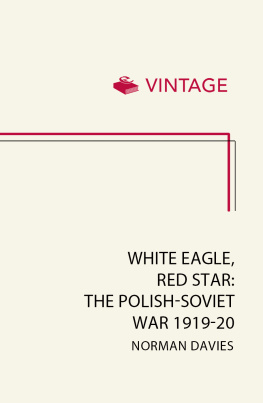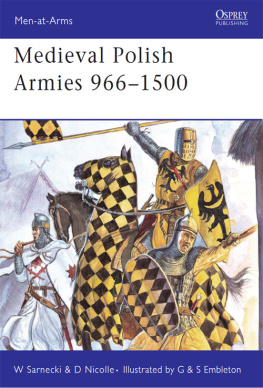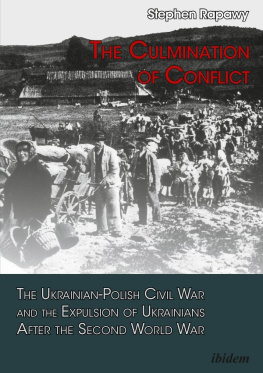Men-at-Arms . 497
Armies of the Russo-Polish War 191921
Nigel Thomas PhD . Illustrated by Adam Hook
Series editor Martin Windrow
CONTENTS
ARMIES OF THE RUSSO-POLISH WAR 191921
The War in Context
T he Armistice of 11 November 1918, which ended the Great War between Germany and the Entente (Allied) powers on the Western Front, was followed by chaotic armed struggles in Central and Eastern Europe. By 1921 these had radically redrawn the maps of several former Russian and Austro-Hungarian imperial possessions, but there is space here for only the briefest summary.
On 10 July 1918 the Soviet Russian Republic was renamed the Russian Soviet Federative Socialist Republic (RSFSR), under the Bolshevik leader Vladimir Ilyich Ulyanov (Lenin). Lenins priority was for his Red Army to consolidate Soviet power around Moscow, and then to eliminate the surrounding White Russian armies a task not finally completed until 1922. Even while the Civil War raged, however, Lenin aimed to absorb all the former regions of the Russian Empire by establishing communist Soviet Socialist Republic (SSR) puppet regimes, e.g. the Lithuanian-Byelorussian (Belarusian) SSR on 28 February 1919; the Ukrainian SSR on 10 March 1919; and the Polish Revolutionary Committee on 27 July 1920. Finally, Lenin planned to export the Bolshevik Revolution across Europe.
Lenins strategy set the Bolsheviks on a collision course with the Second Polish Republic, established on 11 November 1918 from Russian or Congress Poland (though a Kingdom of Poland had been declared on 5 November 1916 by German occupation forces) and the former Austrian Kingdom of Galicia. This emerging Polish state was soon joined by three more regions: German Posen (Pozna) or Greater Poland province, on 16 February 1919 following the Polish rebellion of 27 December 1918; the Russian Biaystok region, also in February 1919; and German West Prussia, awarded to Poland by the Treaty of Versailles on 28 June 1919.
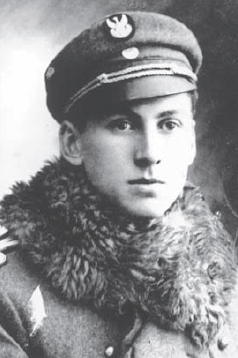
2nd Lt Zdzisaw Niesioowski, photographed in 1919 wearing the M1917 Polish Armed Forces (PSZ) cavalry uniform. The following year he would fight as a lieutenant with Maj Stefan Dembinskis 9th Lancers (part of 7th Cav Bde, 1st Cav Div), which charged the Bolshevik Konarmiya at Komarw on 31 August 1920 in the greatest cavalry battle since 1813. His maciejowka cap shows the officers silver rosette and the crimson branch-colour welt around the band immediately below it; but the eagle badge is non-standard, the chin cords are against regulations, and the commemorative badge visible on the right side is unofficial. He wears an Austro-Hungarian style cavalry overcoat with black lambswool collar, and M1917 service-dress trefoil silver wire shoulder straps with crimson underlay. (Polish Institute & Sikorski Museum, London)
The (eastern, ex-Russian) Ukrainian Peoples Republic (UNR), ruled from 14 December 1918 by Symon Petliuras Directory government based in Kyiv (Kiev), was threatened by both Red and White Russian forces; it concluded an anti-Russian alliance with Poland on 21 April 1920, but was defeated by Bolshevik forces on 21 November 1920. Meanwhile Jzef Pisudski, the Polish head of state, was determined to annex the so-called Eastern Borderlands (Pol, Kresy) comprising Ukrainian-controlled Eastern Galicia and Volhynia, Eastern Lithuania and Western Belarus, all of which had significant Polish populations. The (ex-Austrian) Western Ukrainian Peoples Republic (ZUNR), established on 1 November 1918 in Eastern Galicia, became the Western UNR Region (ZOUNR) on 22 January 1919, but was defeated by Poland on 17 July 1919.

Jzef Pisudski (seated centre, second from right, with hands folded on sword hilt) in 1919. Left of him, in front of the pale-uniformed French staff officer, sits Gen Paul Henrys, head of the 400-strong French military mission to Poland. Pisudski wears his M1915 field-grey uniform (see ); the other Polish officers have M1917 PSZ uniforms with trefoil shoulder straps. The French mission, from 1 April 1919 to 30 September 1920, helped train the Polish General Staff, and initiated a strong French military influence that lasted until September 1939. (Polish Institute & Sikorski Museum, London)
The Belarusian Peoples Republic (BNR) declared independence on 25 March 1918, but was overthrown on 5 January 1919 by the Bolsheviks, who had declared a Belarusian (later Lithuanian-Byelorussian) SSR on 1 January 1919; however, BNR troops fought for Poland from 9 June to 30 September 1920. Polish forces proclaimed the Central Lithuanian Republic in Eastern Lithuania on 12 October 1920, and Poland annexed it on 24 March 1922.
The Russo-Polish War broke out on 16 February 1919, and ended in Polands favour with the Treaty of Riga on 18 March 1921. Its climax was the Polish victory at the Battle of Warsaw in August 1920, the most significant battle of the post-Great War period. It preserved the Polish state and discouraged further Bolshevik military adventures in Central and Eastern Europe, thereby delaying the arrival of communism until 1944; but it also left Poland with Eastern Borderlands with large Belarusian and Ukrainian populations a permanent source of dispute with the Soviet Union.
For further explanation of the fragmentation of Ukraine, 191821, and a useful map, see MAA 412 Ukrainian Armies 191455.
POLISH MILITARY ORGANIZATION
(For reasons of space, abbreviations are widely used in the text that follows.) The first independent Polish military units were organized from 30 Oct 1918 by the Regency Council of the Kingdom of Poland, the only functioning Polish government. The Polish Army (Wojsko Polskie) was formed on 11 Nov 1918, and included the Army Air Service (Wojska Lotnicze) and Navy (Marynarka Wojenna), established on 28 Nov 1918. Jzef Pisudski was immediately appointed Commander-in-Chief (Komendant gowny) of the armed forces, and, on 22 Nov, Provisional Head of State (Tymczasowy Naczelnik Pastwa), confirmed on 20 Feb 1919. The Chief of General Staff of the Polish Army (Szef Sztabu Generalnego Wojska Polskiego) was MajGen Tadeusz Rozwadowski from 28 Oct 1918; LtGen Stanisaw Szeptycki, 10 Nov 1918; MajGen Stansisaw Haller, 7 Feb 1919; and LtGen Tadeusz Rozwadowski from 22 July 1920. The CGS reported to the Minister of Military Affairs, always an Army officer.
Initially the Polish Army was an untidy fusion of seven contingents, each with different training, traditions and uniforms:
(1) 9,000 volunteers in 1st3rd Inf Regts of the Polish Armed Forces (Polskie Siy Zbrojne PSZ; Ger, Polnische Wehrmacht), which had been formed on 10 Apr 1917 in Congress Poland; also 15,000 from the Austro-Hungarian Polish Legions (Legiony Polskie).
(2) 75,000 Poles from I, X & XI Corps Districts of the AH Common Army (Gemeinsame Armee) and Austrian Territorial Army (Landwehr).
(3) About 30,000 volunteers organized by the Regency Council from the clandestine Polish Military Organization (Polska Organizacja Wojskowa POW), and formed into 12 District Inf Regiments.
(4) About 55,000 members of Polish IIII Corps, 4th & 5th Rifle Divs and the 400-strong Murmansk Group, who had been serving in the Russian Army since Oct 1914.
Next page
